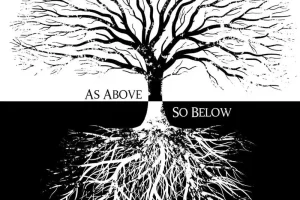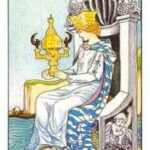 The first sacred law of psyche, the Law of Correspondence, says that the outer universe is a reflection of the realities of our inner universe. This intuition gave rise to the ancient adages, “As above, so below,” and “As without, so within.” Humanity has expressed this relationship in diverse symbol systems like mythology, religion, tarot, alchemy, astrology, magic, literature, and film. Imaginative languages like this have always awakened minds that are trapped in prisons of dry reason, rigid logic, and literal belief. They connect our egos not only to the sacred world outside of ourselves, but also to the corresponding sacred world of the psyche of which we are mostly unaware.
The first sacred law of psyche, the Law of Correspondence, says that the outer universe is a reflection of the realities of our inner universe. This intuition gave rise to the ancient adages, “As above, so below,” and “As without, so within.” Humanity has expressed this relationship in diverse symbol systems like mythology, religion, tarot, alchemy, astrology, magic, literature, and film. Imaginative languages like this have always awakened minds that are trapped in prisons of dry reason, rigid logic, and literal belief. They connect our egos not only to the sacred world outside of ourselves, but also to the corresponding sacred world of the psyche of which we are mostly unaware.
This law means that if we believe in a spiritual reality “up there” or “out there,” it’s because our psyches are furnished with a central archetype of wholeness that Jung called the Self — also called our religious function. The Self contains all our archetypes and their potential for good and evil. As long as we don’t understand that good and evil are very real forces within us, we automatically project the positive sides of archetypes onto a loving heavenly God whom we worship to earn favor and protection from evil. Some of us project the negative, or evil aspects of the archetypes onto a Devil who influences from his home in Hell. We do this with the hope that our good God will protect us from suffering.
Myths are imaginative stories about humanity’s relationship with the sacred mystery of life. They depict the archetypal forces for good and evil within us that can enhance or destroy our lives. It rarely occurs to many of us that as our our forebears grew in self-awareness they created new myths about gods and goddesses that reflected their new ideas about life. We thought our very lives depended on believing that our religion’s traditional myths told the only true stories about our outer deities and how we must respond to them.
In fact, we all believe in myths that are partly based on our reactions to our culture’s religious beliefs and partly on how we interpret our own life-changing experiences. Moreover, we can change our lives for the better by remything our stories to reflect our growing insights about our souls’ truths. An example of how I’ve done this comes from a devastating dream I had at the age of ten. In it, my childhood hero, the Lone Ranger, shot me. If you don’t know about this dream you can find it here. The dream was filled with images and actions that awakened me to the shadow side of the masculine God I believed in. It instigated some negative beliefs about myself and the patriarchal culture I grew up in.
Until I began to study Jungian psychology and take my dream images seriousIy, I couldn’t see any connection between the outer-world God-image I believed in and the daily woundedness I struggled to banish to my inner world. But when my struggles became too painful to ignore, I began to record my dreams and apply an imaginative and metaphoric way of understanding to their symbolic images. Within three years of committed dreamwork, my inner work gave me the insights and courage I needed to resign from work that held little meaning for me and write a book about what I was learning. My manuscript was purchased by a California press and published with the title, The Bridge to Wholeness: A Feminine alternative to the Hero Myth.
Our goal in life is to accept and connect the laws of both worlds in new myths that resonate with our souls and guide us to wholeness. Remything my story changed my life in the most positive way imaginable. This is what the sacred Law of Correspondence is all about.
This law says that the mystery of life is not some idealized, inflated, grandiose, anthropomorphic image of the human ego in the sky. Rather, it is an unimaginably vast and diverse field of connected opposites in which our minimally conscious egos and bodies are immersed without knowing it. This universe is both outside and within us. It contains archetypal forces that influence and shape our lives every bit as much as the forces of gravity, magnetic fields, weather, geography, our environments, our families, our experiences, and our religions shape us from the outside.
You can develop a broader consciousness capable of seeing this larger reality. For this to happen you have to acknowledge your suffering and find the courage to question your traditional beliefs. You need to use your imagination to entertain new ideas and images that feel meaningful in strange, unexpected ways. Perhaps you dream about a fascinating image. Perhaps you experience bizarre coincidences that cannot be attributed to chance. Perhaps unimaginable tragedies destroy your sacred beliefs.
Experiences like this are wake-up calls from your unconscious Self. They show up when you’re ready to take the realities of your life seriously. You can let them destroy your trust in life or you can remyth your story into one that guides you to wholeness. It’s not easy. You will suffer crippling doubt, dread, and loss of faith. But if you trust life’s processes you will learn that the only thing you lost faith in was the inadequate ideas you learned from your family and religion. And you will transcend them.
Has the sacred law of correspondence changed your story? How?
Paper and E-book versions of The Bridge to Wholeness and Dream Theatres of the Soul are at Amazon. The Wilbur Award-winning Healing the Sacred Divide can be found at Amazon and Larson Publications.com. Jean’s new Nautilus Award-winning The Soul’s Twins, is at Amazon and Schiffer’s Red Feather Mind, Body, Spirit. Subscribe to her newsletter at www.jeanbenedictraffa.com.



